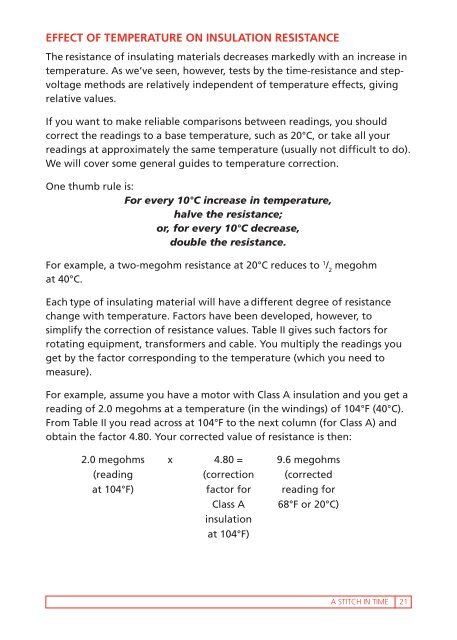“A Stitch in Time...”
You also want an ePaper? Increase the reach of your titles
YUMPU automatically turns print PDFs into web optimized ePapers that Google loves.
EFFECT OF TEMPERATURE ON <strong>in</strong>sulation Resistance<br />
The resistance of <strong>in</strong>sulat<strong>in</strong>g materials decreases markedly with an <strong>in</strong>crease <strong>in</strong><br />
temperature. As we’ve seen, however, tests by the time-resistance and stepvoltage<br />
methods are relatively <strong>in</strong>dependent of temperature effects, giv<strong>in</strong>g<br />
relative values.<br />
If you want to make reliable comparisons between read<strong>in</strong>gs, you should<br />
correct the read<strong>in</strong>gs to a base temperature, such as 20°C, or take all your<br />
read<strong>in</strong>gs at approximately the same temperature (usually not difficult to do).<br />
We will cover some general guides to temperature correction.<br />
One thumb rule is:<br />
For every 10°C <strong>in</strong>crease <strong>in</strong> temperature,<br />
halve the resistance;<br />
or, for every 10°C decrease,<br />
double the resistance.<br />
For example, a two-megohm resistance at 20°C reduces to 1 / 2<br />
megohm<br />
at 40°C.<br />
Each type of <strong>in</strong>sulat<strong>in</strong>g material will have a different degree of resistance<br />
change with temperature. Factors have been developed, however, to<br />
simplify the correction of resistance values. Table II gives such factors for<br />
rotat<strong>in</strong>g equipment, transformers and cable. You multiply the read<strong>in</strong>gs you<br />
get by the factor correspond<strong>in</strong>g to the temperature (which you need to<br />
measure).<br />
For example, assume you have a motor with Class A <strong>in</strong>sulation and you get a<br />
read<strong>in</strong>g of 2.0 megohms at a temperature (<strong>in</strong> the w<strong>in</strong>d<strong>in</strong>gs) of 104°F (40°C).<br />
From Table II you read across at 104°F to the next column (for Class A) and<br />
obta<strong>in</strong> the factor 4.80. Your corrected value of resistance is then:<br />
2.0 megohms x 4.80 = 9.6 megohms<br />
(read<strong>in</strong>g (correction (corrected<br />
at 104°F) factor for read<strong>in</strong>g for<br />
Class A 68°F or 20°C)<br />
<strong>in</strong>sulation<br />
at 104°F)<br />
A STITCH IN TIME 21



